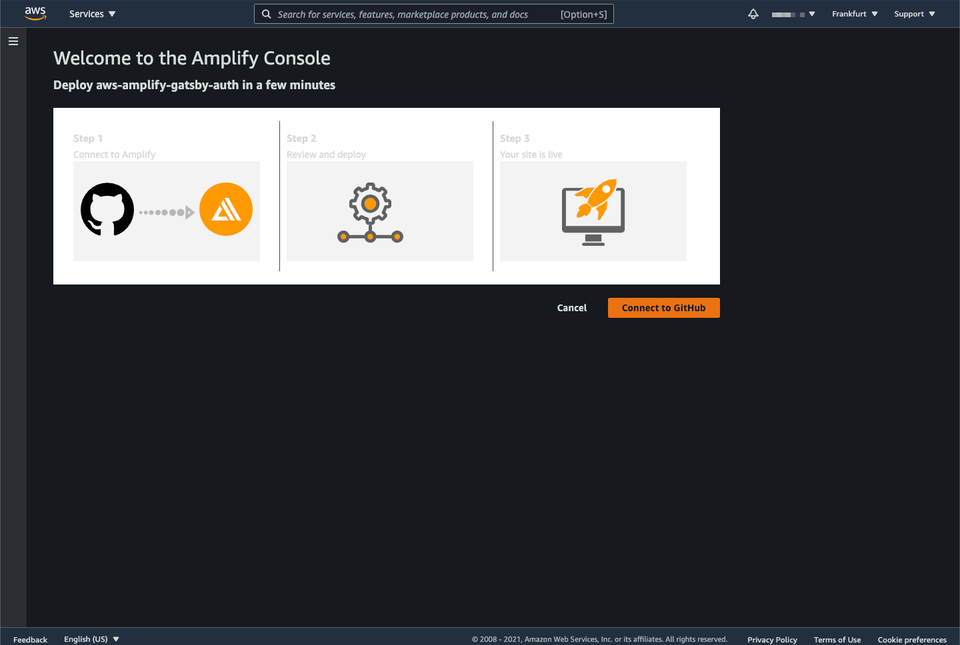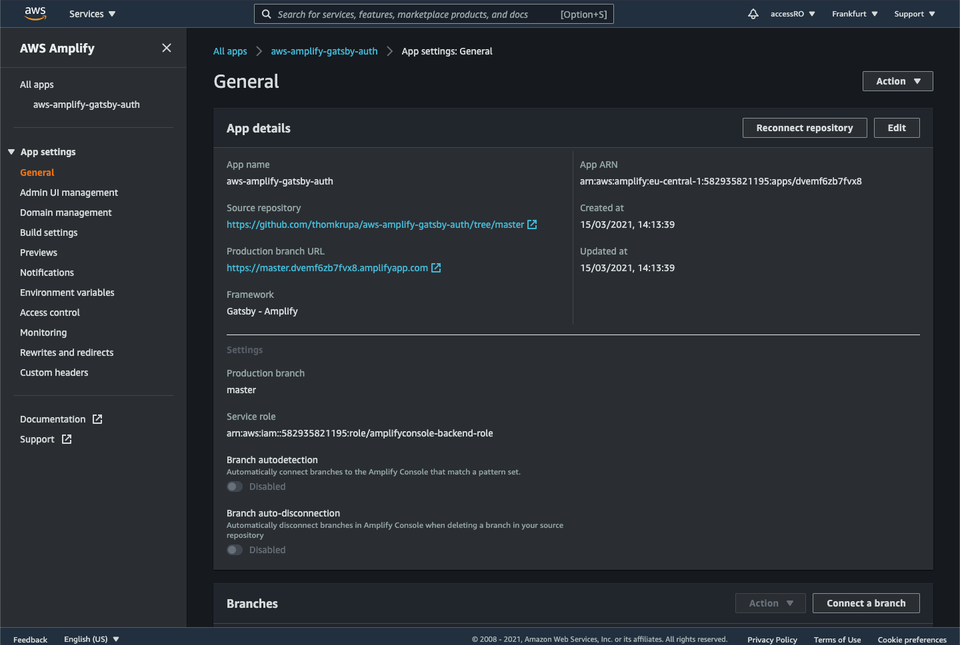Updated on 5/15/2025
What is AWS Amplify: A Review of Deployment Features
 TK
TKThom KrupaCTO
Feature |  AWS Amplify AWS Amplify | |
|---|---|---|
Infrastructure What runs under-the-hood. | AWS | |
Continuous Integration & Continuous Delivery (CI/CD) | ||
Continuous deployment Imagine an automatic update system for your website. This feature automatically deploys any changes you make to your code (usually from Git) to your live website. | ||
Automated builds from Git An easy integration with popular Git repository hostings like Github, GitLab and Bitbucket. | ||
Instant rollbacks to any version Easy way to promote any previous build to production without the need to revert commits or data changes. | Requires configuration | |
Site previews for every push New build with a unique URL for every commit and pull request. | ||
Compatible with all Static Site Generators | ||
Notifications Events triggered on successful, canceled, or failed build. | Email, AWS Chatbot chat notifications, or AWS Console Mobile App push notifications | |
Team Management Create team account and invite your teammates to the project. | ||
Custom domains Bring your own domain and connect to the project. | ||
Automatic HTTPS SSL certificate generated automatically. | ||
Rewrites & Redirects HTTP 301 or 302 redirects from one URL to another. Rewrites work similar to reverse proxy and allow to send user to different URL without modifying the original URL. | ||
Password Protection An easy way to restrict access to the website for users who don't have password. Useful if you work on a new site and want to keep it in secret. | ||
Skew Protection Skew Protection ensures client and server versions stay synchronized during deployments, preventing compatibility issues. | ||
Free Tier | ||
Websites Number of projects you can have in Free Tier on one account. | Unlimited | |
Build Minutes The amount of time your build scripts can run per month. | 1 000 minutes /month for the first 12 months | |
Concurrent builds How many builds can be run at the same time? | N/A | |
Bandwidth The amount of data that is transferred to or from the CDN. | 15GB /month for the first 12 months | |
Team Members The number of users (team members) that can be added to the CMS. | Unlimited | |
Build Time Per Deployment Build have to finish within the limited time. If not it will fail due to timeout. | 30 minutes Can be increased by setting a custom _BUILD_TIMEOUT env variable. | |
Build Memory Limit (in MiB) The amount of memory that is allocated by system to build process. Some operations like image processing are expensive and might require more memory. For Node.js it is max-old-space-size setting. | 2048 MiB Can be increased to 8196 MiB | |
Paid Plans | ||
Max team members before switch to custom pricing | Unlimited | |
Git contributors have to be Team Members In order to triger build, Git contributor has to be a paid team member. | ||
Serverless | ||
Serverless Functions (API) Small pieces of code that run on-demand without managing servers, typically used for API endpoints. | Node.js, Java, Go, .NET Core, Python | |
Edge Functions Serverless functions that run closer to the user, reducing latency and improving performance. | CloudFront | |
Background Functions Code that runs in the background on the platform to perform tasks that don't require immediate user interaction. | ||
CRON Jobs Schedule tasks to run automatically at specific times or intervals. Useful for automating repetitive website maintenance tasks. | Schedule functions | |
Developer Experience | ||
CLI Command Line Interface tools that allow developers to perform tasks and manage the tool via the command line. | amplify | |
Extensions Additional plugins or add-ons that can enhance the functionality of the platform. | ||
Environment Variables Secret configuration settings for your website that change based on where it's deployed (dev, staging, production). | ||
Build Logs Track the progress and results of website builds for troubleshooting | ||
Build Canceling Ability to stop a build process that is currently running. This frees up resources and lets you make changes to your website faster by stopping builds you don't need anymore. | ||
Platform Built-in Products | ||
Analytics Tools for tracking and analyzing website traffic. | Integration with AWS Pinpoint | |
Authentication Services for managing user logins and authentication. | Integration with Amazon Cognito | |
Database Managed database services. | Powered by AWS AppSync and Amazon DynamoDB | |
Asset Optimizations Tools for optimizing images, CSS, JS, etc. | ||
A/B Testing Lets you test different versions of your site by directing traffic to each variant, helping you optimize user experience based on performance metrics. | ||
Form Handling Services for managing form submissions. | ||
Data Storage Solutions for storing and managing data. | ||
Push Notifications This allows your website to send real-time alerts or updates to visitors who have opted-in. | ||
Machine Learning | ||
Security & Compliance Offerings | ||
Two-factor authentication Adds an extra layer of security when logging in. | ||
Team Logs Tracks user activity within the platform for better accountability. | Possible with AWS IAM and CloudTrail | |
SOC2 Service Organization Control 2 compliance for managing customer data. | ||
ISO27001 International standard for information security management. | ||
GDPR Compliance with the General Data Protection Regulation for handling personal data. | ||
Sustainability | ||
Carbon Neutral | ||
Carbon-free Energy | AWS promised to run on 100% renewable energy by 2025 | |
Integrations | ||
Integrations Connecting your deployment platform with external services like headless content, commerce, databases, and more. | ||
Custom build-system integrations Allows you to connect your own build tools and processes with the deployment platform. | AWS CodePipeline | |
Support with self-hosted instances of git | ||
API mesh API Mesh allows you to combine multiple APIs into a single unified API, simplifying data fetching and integration across different services and backends. | ||
Deploy Preview feedback integrations Enables team members and stakeholders to comment directly on preview deployments. | N/A | |
Edge Functions integrations | ||
High Performance Build Memory and CPU | N/A | |
Native Build Plugins | ||
S3 as static hosting
Amazon Web Services (AWS) launched S3 in 2006, a cheap, scalable, high availability, and low latency object storage. It provides an option to host a static website but doesn't offer a build pipeline.
Amplify
Amplify is a fully managed static hosting solution for modern Jamstack projects. It handles CI/CD and CDN.
There is no need to deal with IAM (which is a service to manage access to other AWS services). No need to configure CloudFront, S3, and CodePipeline. All you need is to connect the git repository and set the build command.
AWS Amplify Console
AWS Amplify Console looks like an Amazon version of Firebase, but instead of GCP, it uses the power of Amazon cloud. Cognito for authentication, AWS AppSync, and Amazon DynamoDB to power real-time database called DataStore.
Dashboard
Let me sum AWS UI and UX in one screenshot:

This is one of the first steps when you're trying to deploy an example Gatsby app. Why dark or light mode if you can have both at once? But joking aside, AWS UI is bad. It has many glitches, it's not very intuitive, and it's hard to manage. Don't get me wrong. AWS is a powerful cloud platform, it has dozens of different products, but it misses a good UX team.

Conclusion
AWS is famous for its complexity. Amplify tries to simplify the most common tasks and use cases. It is a step in the right direction. Amplify focuses on user experience and gives frontend developers one of the easiest ways to use and connect various AWS products.
Use cases
- Backend as a service for mobile and web apps.
- Static hosting
Pros & Cons
| AWS Amplify | vs Pros | vs Cons |
|---|---|---|
Automatic HTTPS | ||
Atomic deploys. Instant, one-click rollback to any version | ||
Handles authentication (Amazon Cognito) | ||
Scheduled functions (like CRON jobs) | ||
Push Notifications and Machine Learning integrations |
 Azure Static Web Apps
Azure Static Web Apps Begin
Begin Cloudflare Pages
Cloudflare Pages Deno Deploy
Deno Deploy Digital Ocean App Platform
Digital Ocean App Platform Firebase
Firebase GitHub Pages
GitHub Pages Heroku
Heroku Kinsta
Kinsta Layer0
Layer0 Netlify
Netlify Render
Render Vercel
Vercel